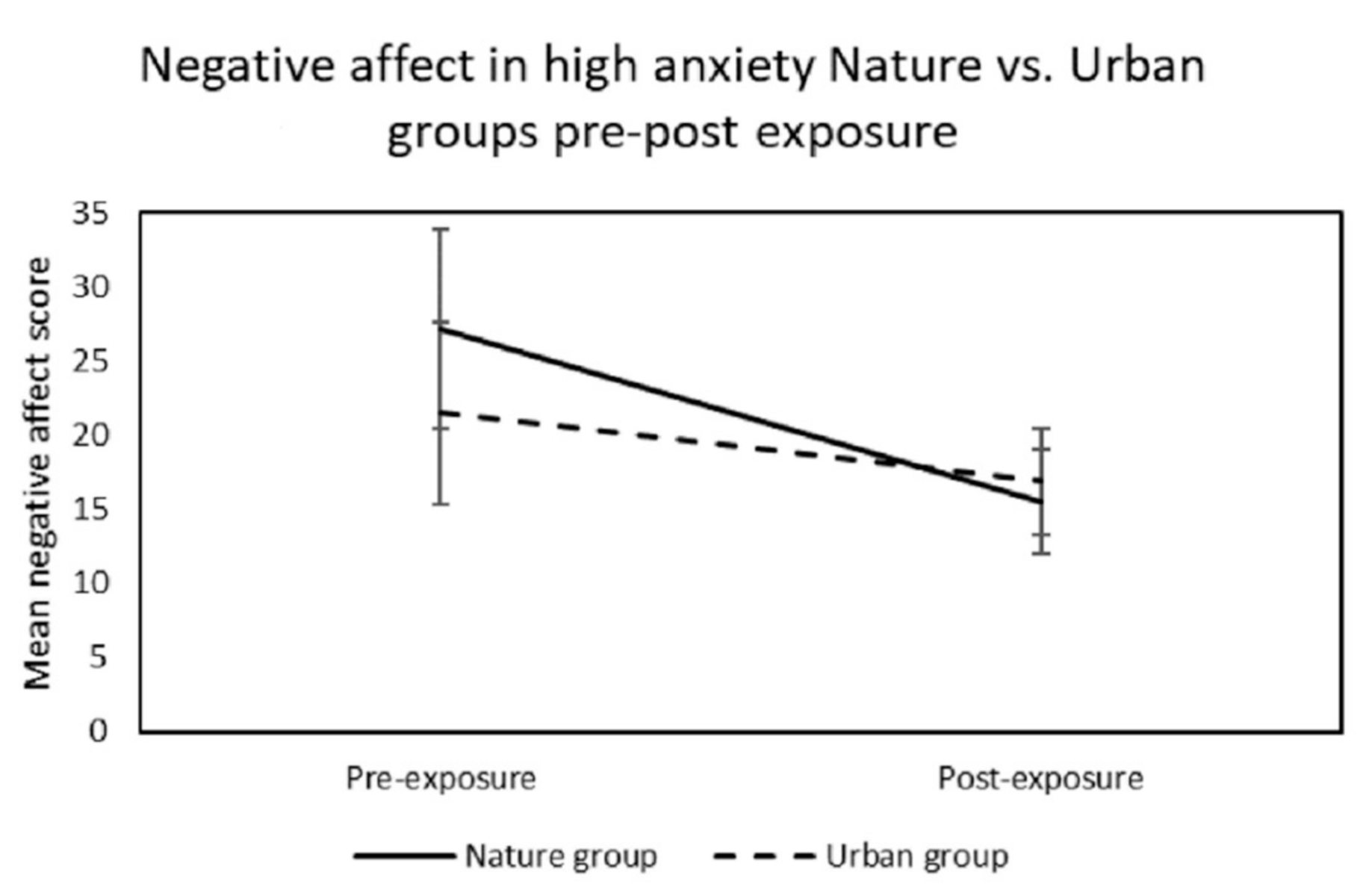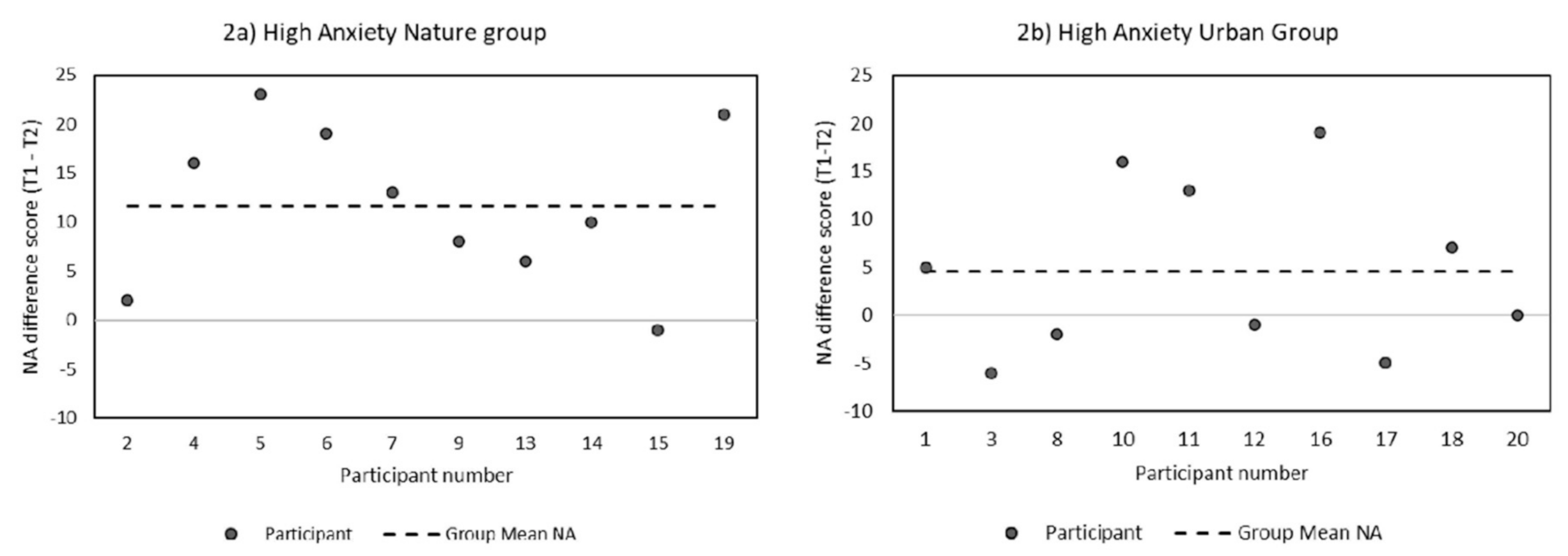Virtual Reality Nature Exposure and Test Anxiety
Abstract
1. Introduction
2. Materials and Methods
2.1. Participants
2.2. Design
2.3. Materials
2.3.1. Test Anxiety Questionnaire
2.3.2. Positive and Negative Affect Schedule (PANAS)
2.3.3. Non-Verbal Reasoning Test
2.3.4. Demographics Questionnaire
2.3.5. Nature Connection Index (NCI)
2.3.6. Motion Sickness Assessment Questionnaire (MSAQ)
2.3.7. Virtual Reality Footage
2.3.8. Virtual Reality Equipment
2.4. Procedure
2.5. Data Analysis
3. Results
3.1. Preliminary Analyses
3.2. Inferential Statistics
3.2.1. Positive Affect Scores
3.2.2. Negative Affect Scores
3.2.3. Test Scores
4. Discussion
4.1. Positive and Negative Affect
4.2. Test Scores
4.3. Limitations
4.4. Implications of the Study
Supplementary Materials
Author Contributions
Funding
Acknowledgments
Conflicts of Interest
References
- Berto, R. The role of nature in coping with psycho-physiological stress: A literature review on restorativeness. Behav. Sci. 2014, 4, 394–409. [Google Scholar] [CrossRef] [PubMed]
- Hartig, T.; Staats, H. Restorative environments. Encycl. Appl. Psychol. 2014, 3, 273–279. [Google Scholar]
- Kaplan, S. Meditation, restoration, and the management of mental fatigue. Environ. Behav. 2001, 33, 480–506. [Google Scholar] [CrossRef]
- Kaplan, R.; Kaplan, S. The Experience of Nature: A Psychological Perspective; CUP Archive: Cambridge, UK, 1989. [Google Scholar]
- Ulrich, R.S.; Simons, R.F.; Losito, B.D.; Fiorito, E.; Miles, M.A.; Zelson, M. Stress recovery during exposure to natural and urban environments. J. Environ. Psychol. 1991, 11, 201–230. [Google Scholar] [CrossRef]
- Hartig, T.; Mang, M.; Evans, G.W. Restorative effects of natural environment experiences. Environ. Behav. 1991, 23, 3–26. [Google Scholar] [CrossRef]
- Tyrväinen, L.; Ojala, A.; Korpela, K.; Lanki, T.; Tsunetsugu, Y.; Kagawa, T. The influence of urban green environments on stress relief measures: A field experiment. J. Environ. Psychol. 2014, 38, 1–9. [Google Scholar] [CrossRef]
- Berto, R. Exposure to restorative environments helps restore attentional capacity. J. Environ. Psychol. 2005, 25, 249–259. [Google Scholar] [CrossRef]
- Bratman, G.N.; Daily, G.C.; Levy, B.J.; Gross, J.J. The benefits of nature experience: Improved affect and cognition. Landsc. Urban Plan. 2015, 138, 41–50. [Google Scholar] [CrossRef]
- Hedblom, M.; Gunnarsson, B.; Iravani, B.; Knez, I.; Schaefer, M.; Thorsson, P.; Lundström, J.N. Reduction of physiological stress by urban green space in a multisensory virtual experiment. Sci. Rep. 2019, 9, 10113. [Google Scholar] [CrossRef]
- Gladwell, V.F.; Brown, D.K.; Barton, J.L.; Tarvainen, M.P.; Kuoppa, P.; Pretty, J.; Sandercock, G.R.H. The effects of views of nature on autonomic control. Eur. J. Appl. Physiol. 2012, 112, 3379–3386. [Google Scholar] [CrossRef]
- Calogiuri, G.; Litleskare, S.; Fagerheim, K.A.; Rydgren, T.L.; Brambilla, E.; Thurston, M. Experiencing nature through immersive virtual environments: Environmental perceptions, physical engagement, and affective responses during a simulated nature walk. Front. Psychol. 2018, 8, 2321. [Google Scholar] [CrossRef] [PubMed]
- De Kort, Y.A.; Meijnders, A.L.; Sponselee, A.A.; IJsselsteijn, W.A. What’s wrong with virtual trees? Restoring from stress in a mediated environment. J. Environ. Psychol. 2006, 26, 309–320. [Google Scholar] [CrossRef]
- Villani, D.; Riva, F.; Riva, G. New technologies for relaxation: The role of presence. Int. J. Stress Manag. 2007, 14, 260. [Google Scholar] [CrossRef]
- Valtchanov, D.; Barton, K.R.; Ellard, C. Restorative effects of virtual nature settings. Cyberpsychol. Behav. Soc. Netw. 2010, 13, 503–512. [Google Scholar] [CrossRef] [PubMed]
- Annerstedt, M.; Jönsson, P.; Wallergård, M.; Johansson, G.; Karlson, B.; Grahn, P.; Währborg, P. Inducing physiological stress recovery with sounds of nature in a virtual reality forest—Results from a pilot study. Physiol. Behav. 2013, 118, 240–250. [Google Scholar] [CrossRef]
- Anderson, A.P.; Mayer, M.D.; Fellows, A.M.; Cowan, D.R.; Hegel, M.T.; Buckey, J.C. Relaxation with immersive natural scenes presented using virtual reality. Aerosp. Med. Hum. Perform. 2017, 88, 520–526. [Google Scholar] [CrossRef] [PubMed]
- Browning, M.H.; Rigolon, A. School green space and its impact on academic performance: A systematic literature review. Int. J. Environ. Res. Public Health 2019, 16, 429. [Google Scholar] [CrossRef] [PubMed]
- Trifoni, A.; Shahini, M. How does exam anxiety affect the performance of university students? Mediterr. J. Soc. Sci. 2011, 2, 93–100. [Google Scholar]
- Putwain, D.W.; Daly, A.L.; Chamberlain, S.; Sadreddini, S. ‘Sink or swim’: Buoyancy and coping in the cognitive test anxiety–academic performance relationship. Educ. Psychol. 2016, 36, 1807–1825. [Google Scholar] [CrossRef]
- Baker, J.; Ainsworth, H.; Torgerson, C.; Torgerson, D. A systematic review and meta-analysis of randomised controlled trials evaluating the effect of hypnosis on exam anxiety. Eff. Educ. 2009, 1, 27–41. [Google Scholar] [CrossRef]
- Zeidner, M. Test Anxiety: The State of the Art; Springer Science & Business Media: Berlin/Heidelberg, Germany, 1998. [Google Scholar]
- Hong, E.; Karstensson, L. Antecedents of state test anxiety. Contemp. Educ. Psychol. 2002, 27, 348–367. [Google Scholar] [CrossRef]
- Onyeizugbo, E.U. Self-efficacy and test anxiety as correlates of academic performance. Educ. Res. 2010, 1, 477–480. [Google Scholar]
- Abulghasemi, A. Text Anxiety, Cause, Evaluation and Treatment. Methodol. Res. 2008, 5, 82–97. [Google Scholar]
- Duraku, Z.H. Factors influencing test anxiety among university students. Eur. J. Soc. Behav. Sci. 2017, 18, 2325. [Google Scholar] [CrossRef]
- Parnabas, V.A.; Mahamood, Y.; Parnabas, J.; Abdullah, N.M. The relationship between relaxation techniques and sport performance. Univers. J. Psychol. 2014, 2, 108–112. [Google Scholar]
- Nguyen, J.; Brymer, E. Nature-based guided imagery as an intervention for state anxiety. Front. Psychol. 2018, 9, 1858. [Google Scholar] [CrossRef]
- Bratman, G.N.; Hamilton, J.P.; Hahn, K.S.; Daily, G.C.; Gross, J.J. Nature experience reduces rumination and subgenual prefrontal cortex activation. Proc. Natl. Acad. Sci. USA 2015, 112, 8567–8572. [Google Scholar] [CrossRef] [PubMed]
- Beilock, S.L.; DeCaro, M.S. From poor performance to success under stress: Working memory, strategy selection, and mathematical problem solving under pressure. J. Exp. Psychol. Learn. Mem. Cogn. 2007, 33, 983. [Google Scholar] [CrossRef] [PubMed]
- Krawietz, S.A. Alleviating Choking under Pressure Using Imagery; ProQuest Dissertations Publishing: Ann Arbor, MI, USA, 2013; pp. 5–13. [Google Scholar]
- Leung, W.T.V.; Tam, T.Y.T.; Pan, W.C.; Wu, C.D.; Lung, S.C.C.; Spengler, J.D. How is environmental greenness related to students’ academic performance in English and mathematics? Landsc. Urban Plan. 2019, 181, 118–124. [Google Scholar] [CrossRef]
- Matsuoka, R.H. Student performance and high school landscapes: Examining the links. Landsc. Urban Plan. 2010, 97, 273–282. [Google Scholar] [CrossRef]
- Kweon, B.S.; Ellis, C.D.; Lee, J.; Jacobs, K. The link between school environments and student academic performance. Urban For. Urban Green. 2017, 23, 35–43. [Google Scholar] [CrossRef]
- Chin, E.C.; Williams, M.W.; Taylor, J.E.; Harvey, S.T. The influence of negative affect on test anxiety and academic performance: An examination of the tripartite model of emotions. Learn. Individ. Differ. 2017, 54, 1–8. [Google Scholar] [CrossRef]
- Richardson, M.; Hunt, A.; Hinds, J.; Bragg, R.; Fido, D.; Petronzi, D.; White, M. A measure of nature connectedness for children and adults: Validation, performance, and insights. Sustainability 2019, 11, 3250. [Google Scholar] [CrossRef]
- Nist, P.; Diehl, M. PHCC Test Anxiety Questionnaire. Available online: https://docplayer.net/24557834-Phcc-test-anxiety-questionnaire.html (accessed on 21 October 2020).
- Watson, D.; Clark, L.A.; Tellegen, A. Development and validation of brief measures of positive and negative affect: The PANAS scales. J. Personal. Soc. Psychol. 1988, 54, 1063. [Google Scholar] [CrossRef]
- Ogundokun, M.O. Learning style, school environment and test anxiety as correlates of learning outcomes among secondary school students. IFE Psychol. Int. J. 2011, 19, 321–336. [Google Scholar] [CrossRef]
- McAllister, S.J.; Vincent, A.; Hassett, A.L.; Whipple, M.O.; Oh, T.H.; Benzo, R.P.; Toussaint, L.L. Psychological resilience, affective mechanisms and symptom burden in a tertiary-care sample of patients with fibromyalgia. Stress Health 2015, 31, 299–305. [Google Scholar] [CrossRef]
- Crawford, J.R.; Henry, J.D. The Positive and Negative Affect Schedule (PANAS): Construct validity, measurement properties and normative data in a large non-clinical sample. Br. J. Clin. Psychol. 2004, 43, 245–265. [Google Scholar] [CrossRef]
- Eleven Plus Exams. (n.d.). Available online: https://www.Elevenplusexams.co.uk/assets/192/CGP11+NonVerbalReasoningTest.pdf (accessed on 1 October 2020).
- Gianaros, P.J.; Muth, E.R.; Mordkoff, J.T.; Levine, M.E.; Stern, R.M. A questionnaire for the assessment of the multiple dimensions of motion sickness. Aviat. Space Environ. Med. 2001, 72, 115. [Google Scholar]
- Tarrant, J.; Viczko, J.; Cope, H. Virtual reality for anxiety reduction demonstrated by Quantitative EEG: A pilot study. Front. Psychol. 2018, 9, 1280. [Google Scholar] [CrossRef]
- Tabachnick, B.G.; Fidell, L.S.; Ullman, J.B. Using Multivariate Statistics; Pearson: Boston, MA, USA, 2007; Volume 5. [Google Scholar]
- Cohen, J. The Effect Size Index: D. In Statistical Power Analysis for the Behavioral Sciences; Academic Press: Cambridge, MA, USA, 1988; Volume 2. [Google Scholar]
- Taylor, C.T.; Lyubomirsky, S.; Stein, M.B. Upregulating the positive affect system in anxiety and depression: Outcomes of a positive activity intervention. Depress. Anxiety 2017, 34, 267–280. [Google Scholar] [CrossRef]
- Kring, A.M.; Persons, J.B.; Thomas, C. Changes in affect during treatment for depression and anxiety. Behav. Res. Ther. 2007, 45, 1753–1764. [Google Scholar] [CrossRef] [PubMed]
- Brown, T.A.; Chorpita, B.F.; Barlow, D.H. Structural relationships among dimensions of the DSM-IV anxiety and mood disorders and dimensions of negative affect, positive affect, and autonomic arousal. J. Abnorm. Psychol. 1998, 107, 179. [Google Scholar] [CrossRef] [PubMed]


| HA | LA | ||||||||
|---|---|---|---|---|---|---|---|---|---|
| T1 | T2 | T1 | T2 | ||||||
| M | SD | M | SD | M | SD | M | SD | ||
| Positive Affect | Nature | 27.80 | 8.59 | 30.80 | 8.94 | 32.00 | 5.57 | 32.60 | 6.68 |
| Urban | 26.80 | 5.69 | 26.90 | 6.98 | 31.60 | 5.56 | 28.00 | 9.63 | |
| Negative Affect | Nature | 27.20 | 9.35 | 15.50 | 4.90 | 13.60 | 4.01 | 11.60 | 2.83 |
| Urban | 21.50 | 8.55 | 16.90 | 5.06 | 13.90 | 3.51 | 11.50 | 2.32 | |
| Test Scores | Nature | 5.20 | 2.25 | 5.40 | 2.17 | 5.60 | 1.83 | 5.40 | 2.06 |
| Urban | 5.50 | 1.58 | 5.20 | 1.98 | 5.80 | 2.14 | 6.20 | 1.68 | |
Publisher’s Note: MDPI stays neutral with regard to jurisdictional claims in published maps and institutional affiliations. |
© 2020 by the authors. Licensee MDPI, Basel, Switzerland. This article is an open access article distributed under the terms and conditions of the Creative Commons Attribution (CC BY) license (http://creativecommons.org/licenses/by/4.0/).
Share and Cite
O’Meara, A.; Cassarino, M.; Bolger, A.; Setti, A. Virtual Reality Nature Exposure and Test Anxiety. Multimodal Technol. Interact. 2020, 4, 75. https://doi.org/10.3390/mti4040075
O’Meara A, Cassarino M, Bolger A, Setti A. Virtual Reality Nature Exposure and Test Anxiety. Multimodal Technologies and Interaction. 2020; 4(4):75. https://doi.org/10.3390/mti4040075
Chicago/Turabian StyleO’Meara, Alison, Marica Cassarino, Aaron Bolger, and Annalisa Setti. 2020. "Virtual Reality Nature Exposure and Test Anxiety" Multimodal Technologies and Interaction 4, no. 4: 75. https://doi.org/10.3390/mti4040075
APA StyleO’Meara, A., Cassarino, M., Bolger, A., & Setti, A. (2020). Virtual Reality Nature Exposure and Test Anxiety. Multimodal Technologies and Interaction, 4(4), 75. https://doi.org/10.3390/mti4040075





